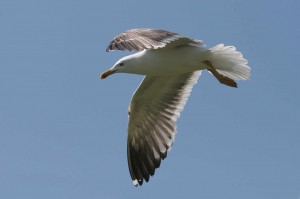The UK Government has a commitment to obtain 15% of the country’s electricity from renewable sources by 2020. Many offshore wind farms are therefore under construction or proposed. These wind farms might affect bird populations through:
- Displacement due to disturbance
- Presenting a barrier to migrating birds and birds commuting between breeding sites and feeding areas
- Collision mortality
- Indirect effects because of changes in habitat or prey availability

This project, which ran from 2010 to 2014, used UvA-BiTS technology to investigate these possible effects, using the Lesser Black-backed Gull as a model species. In summers 2010 and 2011, UvA-BiTS tags were fitted to 25 adult Lesser Black-backed Gulls, breeding at Orford Ness on the east coast of England (52°4’N, 1°33’E). Several existing and proposed wind farms are close to Orford Ness, which is part of the Alde-Ore Estuary Special Protection Area (SPA). The breeding population of Lesser Black-backed Gulls is one of the designated features of this site. However, this breeding population is in decline, falling from approximately 20,000 pairs in 1999 to 550 in 2010.
The study assessed interactions with wind farms both in the breeding season and through migration and wintering periods. The risk of seabirds colliding with offshore wind turbines is influenced by flight height, and analyses also considered the flight altitude data derived from the GPS devices.

For information on the other part of this project, tagging Great Skuas on Foula SPA, see:
Contact persons, funders and participants
Chris Thaxter, British Trust for Ornithology chris.thaxter@bto.org
Niall Burton, British Trust for Ornithology niall.burton@bto.org
Viola Ross-Smith, British Trust for Ornithology viola.ross-smith@bto.org
Willem Bouten, University of Amsterdam Institute for Biodiversity and Ecosystem Dynamics / Instituut voor Biodiversiteit en Ecosysteem Dynamica (IBED) w.bouten@uva.nl
This study was sponsored by the Department of Energy & Climate Change.
This study was supported by the National Trust
Related publications
Thaxter, C.B., Clark, N.A., Ross-Smith, V.H., Conway, G.J., Bouten, W. & Burton, N.H.K. 2017. Sample size required to characterize area use of tracked seabirds. Journal of Wildlife Management 81: 1098-1109
Ross-Smith, V.H., Thaxter, C.B., Masden, E.A., Shamoun-Baranes, J., Burton, N.H.K., Wright, L.J., Rehfisch, M.M. & Johnston, A. 2016. Modelling flight heights of Lesser Black-backed Gulls and Great Skuas from GPS: a Bayesian approach. Journal of Applied Ecology 53: 1676–1685.
Thaxter, C.B., Ross-Smith, V.H., Clark, J.A., Clark, N.A., Conway, G.J., Masden, E.A., Wade, H.M., Leat, E.H.K., Gear, S.C., Marsh, M., Booth, Furness, R.W., Votier, S.C. & Burton, N.H.K. 2016. Contrasting effects of GPS device and harness attachment on adult survival of Lesser Black-backed Gulls Larus fuscus and Great Skuas Stercorarius skua. Ibis 158: 279-290.
Thaxter, C.B., Ross-Smith, V.H., Bouten, W., Rehfisch, M.M., Clark, N.A., Conway, G.J. & Burton, N.H.K. 2015. Seabird-wind farm interactions during the breeding season vary within and between years. Biological Conservation 186: 347-358.
Thaxter, C.B., Ross-Smith, V.H., Clark, J., Clark, N.A., Conway, G.J., Marsh, M., Leat, E.H.K & Burton, N.H.K. 2014. A trial of three harness attachment methods and their suitability for long-term use on Lesser Black-backed Gull and Great Skua. Ringing & Migration 29: 65-76.

